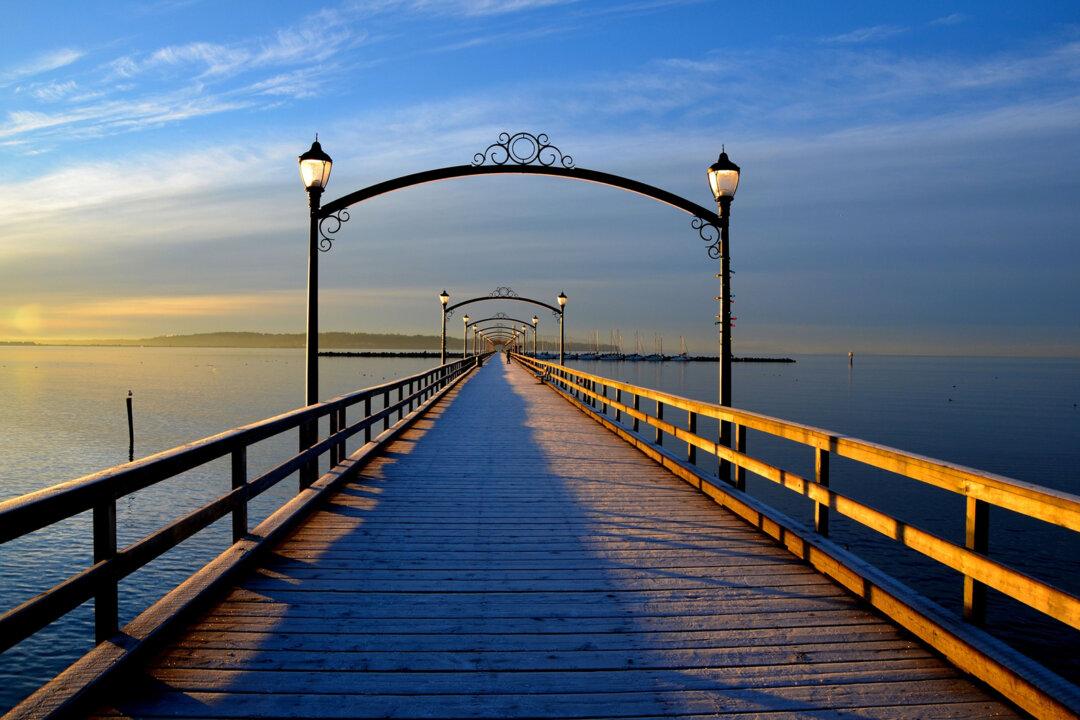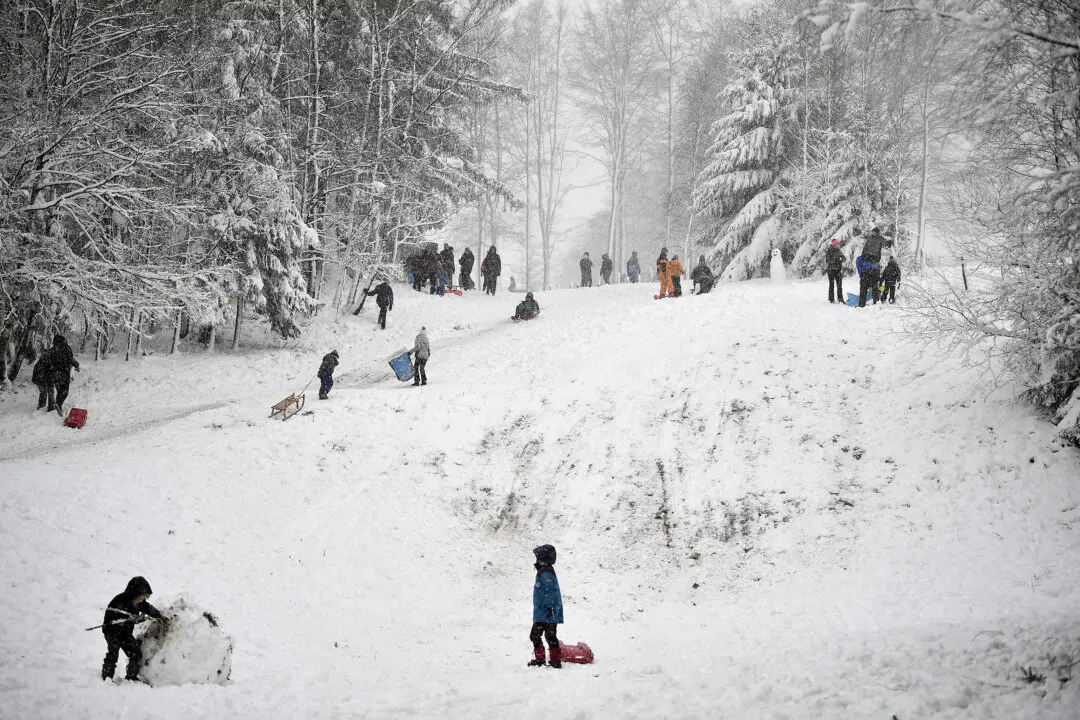White Rock—Under a toasty July sun with Mount Baker shimmering on the horizon, I waded off the beach and dived underwater, expecting the usual sharp intake of breath that accompanies a plunge into Puget Sound. Except, it never came. Instead of the cold shock to the system that I’ve long considered the price of admission for saltwater swimming in the Northwest, the water was downright balmy. No wonder so many bathers—including one mermaid in her element—were splashing around Semiahmoo Bay off the beaches of White Rock, British Columbia.
A shallow bay, it turns out, allows our normally frigid Pacific Ocean currents to warm under summer sun rays, making White Rock’s beaches more Mediterranean than Arctic. Canadians quickly figured out this oceanographic anomaly in the early 20th century and established a seaside resort town on what was the traditional lands of a Coast Salish tribe called the Semiahmoo. (Today the Semiahmoo First Nation has just 312 acres of reserve land bordering White Rock.)
Over a century later, White Rock still draws summer crowds to what I believe is the finest true beach town on the Salish Sea, the inland marine waters of Washington and British Columbia. It has a landmark pier offering stunning mountain and island vistas, a lovely promenade for sea breeze-scented strolls and a charming oceanfront commercial strip with surprisingly eclectic food and drink offerings, all fronting an expansive beach with a rare commodity: warm saltwater.
While traversing the Peace Arch border crossing come summertime is often the jumping-off point for a grand adventure, White Rock is hiding in plain sight—the very first town on the Canadian side, visible to your left as you crest the final miles of Interstate 5 in Blaine. At 115 miles from Seattle, it’s close enough for a long day trip but makes for a worthy overnight getaway before beach season is behind us.
From a home base in White Rock, explore the beaches, parks, trails and towns along Boundary Bay— including Washington exclave Point Roberts.
Where to Stay and What to Eat
White Rock is a densely packed town that rises steeply up from the oceanside, which means commanding views are easy to come by even just a block or two inland. Short-term vacation rentals abound—to ensure your digs are legally operated, make sure the host’s business license number is included with the listing. In early July, my family of three booked a one-bedroom unit with a pullout sofa for $240 per night after taxes and fees on Airbnb. But short-term rental booking platforms are often a crapshoot. While the location one block from the beach was ideal, our rental was in poor shape.
In hindsight, I wish we had considered the Ocean Promenade Hotel, a 72-room lodging property and the town’s only beachfront hotel. White Rock is also home to several bed-and-breakfasts, like the Star of the Sea Guest House, just three blocks inland from the beach.
Light sleepers be warned: Like every beach from Golden Gardens on north, the BNSF railroad tracks hug the coast here and trains will rumble through in the wee hours.
Whether hunting for lunch to take back to your towel, an après-beach aperitif or dinner after a day in the sun, you’ll spend much of your time along Marine Drive. This ocean-facing strip is chockablock with cafes, bars, restaurants and shops. From seafood joints to ice cream parlors, Marine Drive leans into the beach town theme—with a Lower Mainland twist.
This end of metro Vancouver is a hub for Chinese cuisine and South Asian food. That culinary influence spills into White Rock, where nestled among the salmon burgers and oyster plates at beach bars like Charlie Don’t Surf are restaurants serving up Cantonese and Indian delights.
At India Chaat House, I followed my warm-water swim with delectable chicken biryani (CA$18) alongside chole bhature (CA$16), or chickpea masala layered atop fried bread. Wash down those spicy flavors with a matcha milk tea from Leieve Tea (CA$7) while strolling the oceanfront promenade and you’ll have what feels like a quintessential B.C. beach day. Here, the region’s natural splendor is enriched by the multicultural fabric of contemporary Canada.
For a more gourmet night out, the most coveted table along Marine Drive is Uli’s Restaurant, which touts a West Coast bistro-inspired menu. As a brilliant evening sun blanketed the patio, an Aperol spritz (CA$13) almost convinced me I was people-watching on the Amalfi Coast. Both the seafood linguine (CA$41) and paella (CA$41) hit fresh-from-the-ocean notes, while a glass of Okanagan Valley sauvignon blanc-semillon blend (CA$16) off a thoughtfully curated wine list brightened my palate. I skipped dessert and meandered across the street on the server’s recommendation to Maya’s Ice Cream for a memorable scoop of hedgehog, a chocolate-hazelnut gelato concoction (CA$10 for two scoops on a waffle cone).
While the evening offered plenty of enticements, I found Marine Drive’s morning offerings comparatively lacking. However, White Rock’s commercial corridors extend uphill to the Uptown district, where a pain au chocolat (CA$4.45) and a macchiato (CA$3.95) at French patisserie Chez Christophe were worth the trek.
Fish and chips, the seaside classic, is a fixture at eateries along Boundary Bay, especially the cluster of competing fish and chips shops along the waterfront commercial strip in White Rock, B.C. (Yiting Lim / Special to The Seattle Times)
Last but not least, no seaside town, least of all one located in a province with the word “British” in its name, is complete without fish and chips. White Rock carries this combo in spades.
Lines seem to form all day at Moby Dick, which touts its legacy as White Rock’s go-to fish and chips shop. When there is an iconic, and often very busy food destination with similar establishments on the same block, I go for the knockoff with shorter lines. (See: Pat’s instead of Geno’s for cheesesteaks in South Philly, or Modern instead of Mike’s for cannoli in Boston’s North End). How good can the tourist trap really be? Don’t the locals prefer the joint with shorter lines?
Operating on that philosophy, I devoured a luscious plate of halibut fish and chips (CA$21.95 for two pieces) from Coney Island Seafood next door. The pleasingly crispy batter encasing juicy white meat was blessedly ungreasy, while the tartar sauce was just the right balance of citrus tang and creamy texture. And despite the New York name, the accompanying potatoes were more chips than fries, that is to say a thicker cut than we’re used to on this side of the border. I didn’t have room to conduct a comparative taste test, but in June a White Rock city councilor caused a kerfuffle when he declared Coney Island the locals’ favorite.






